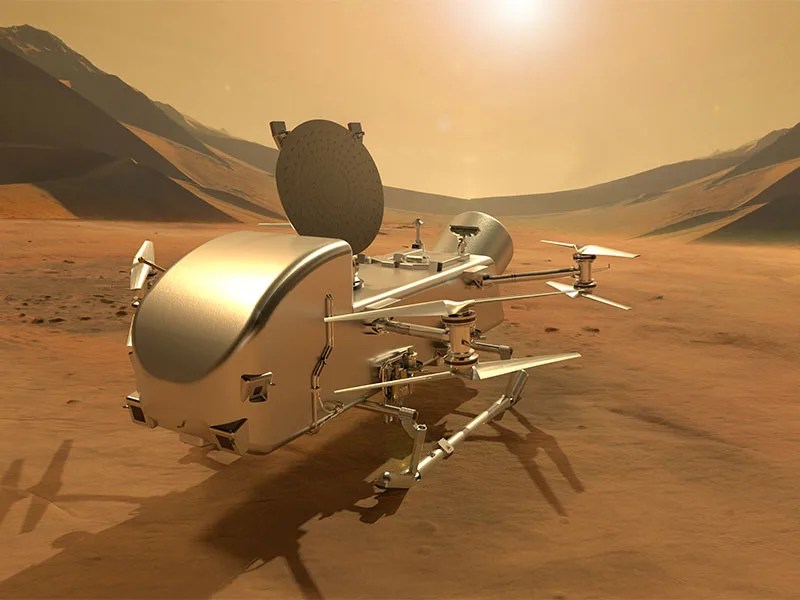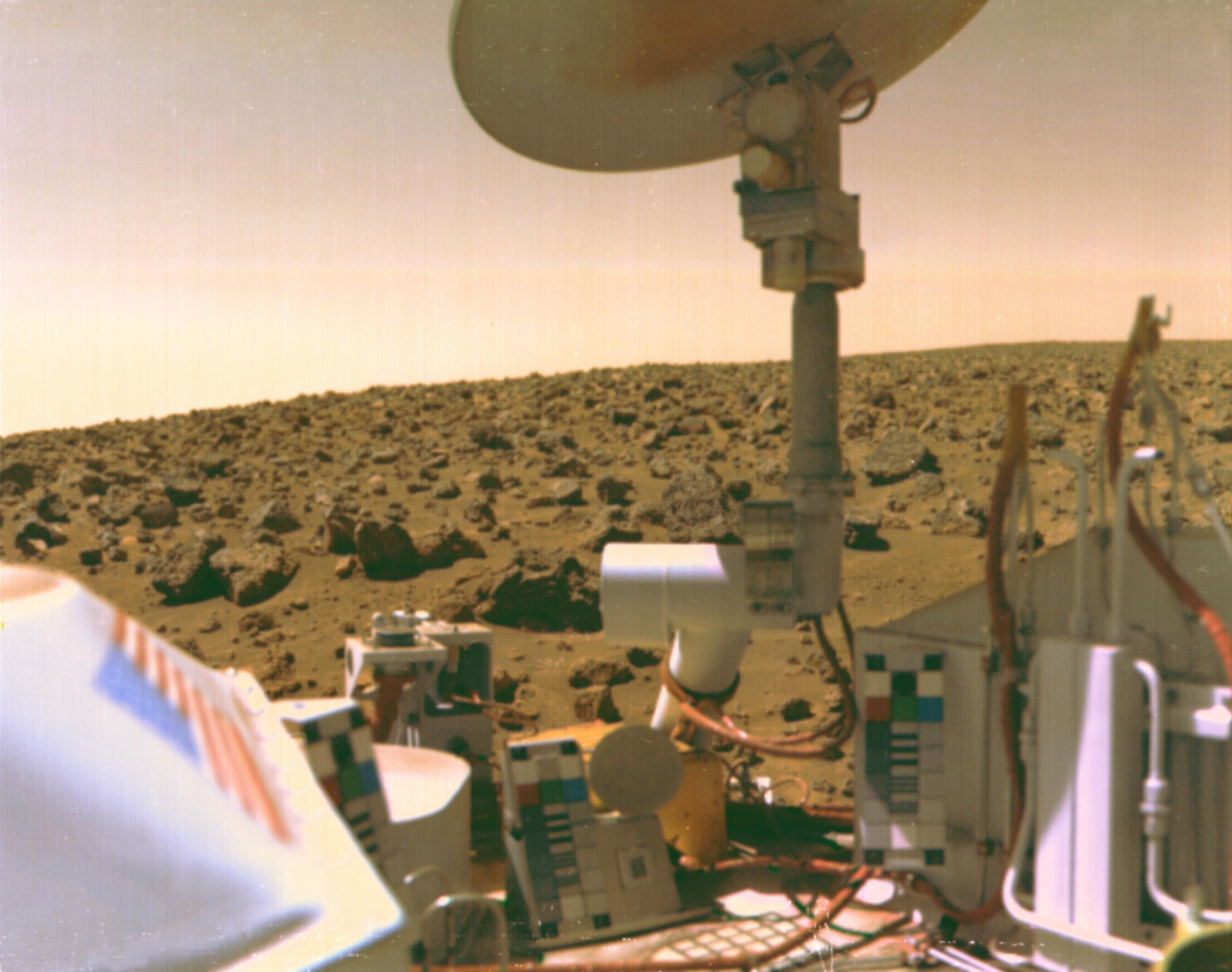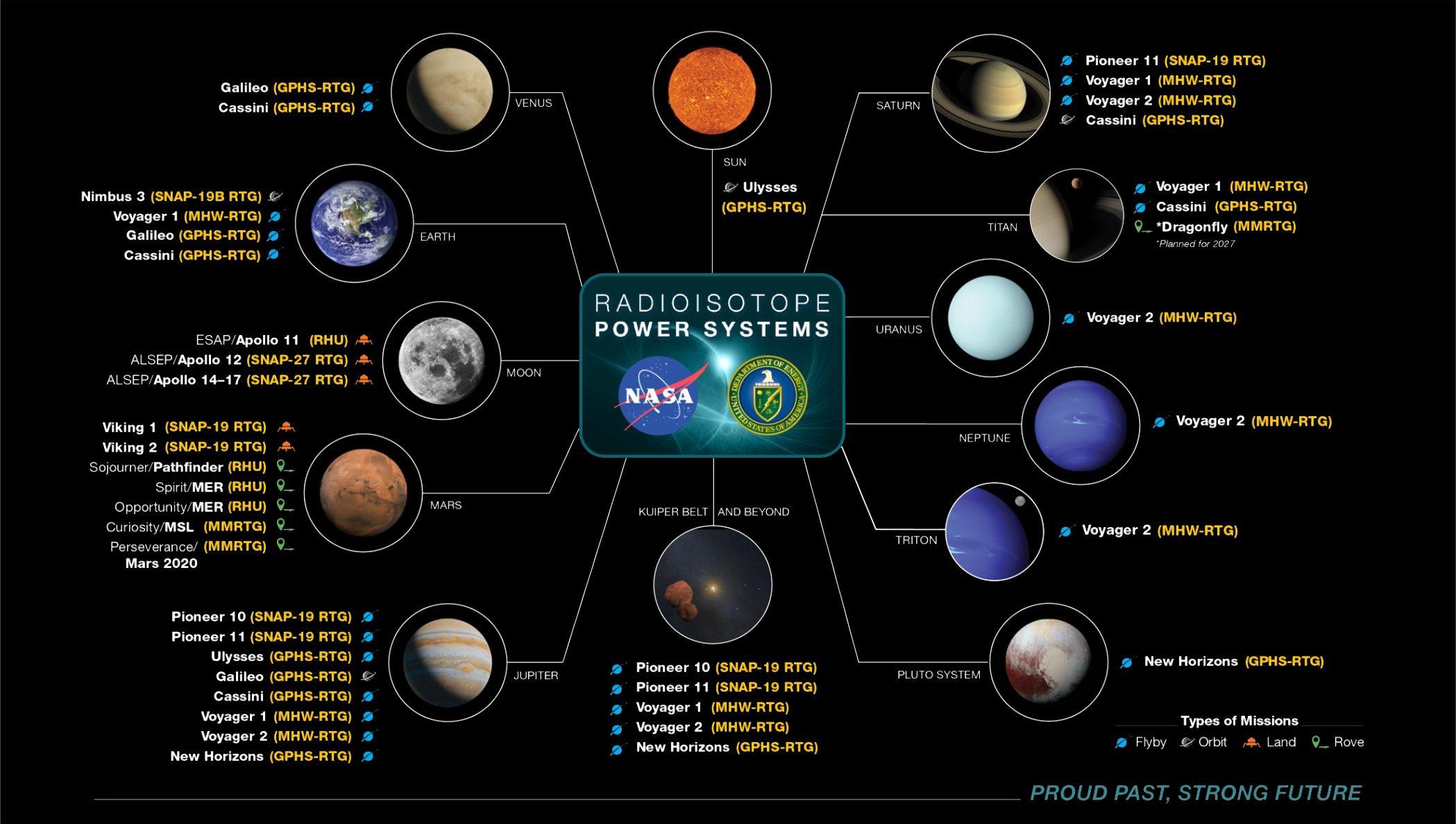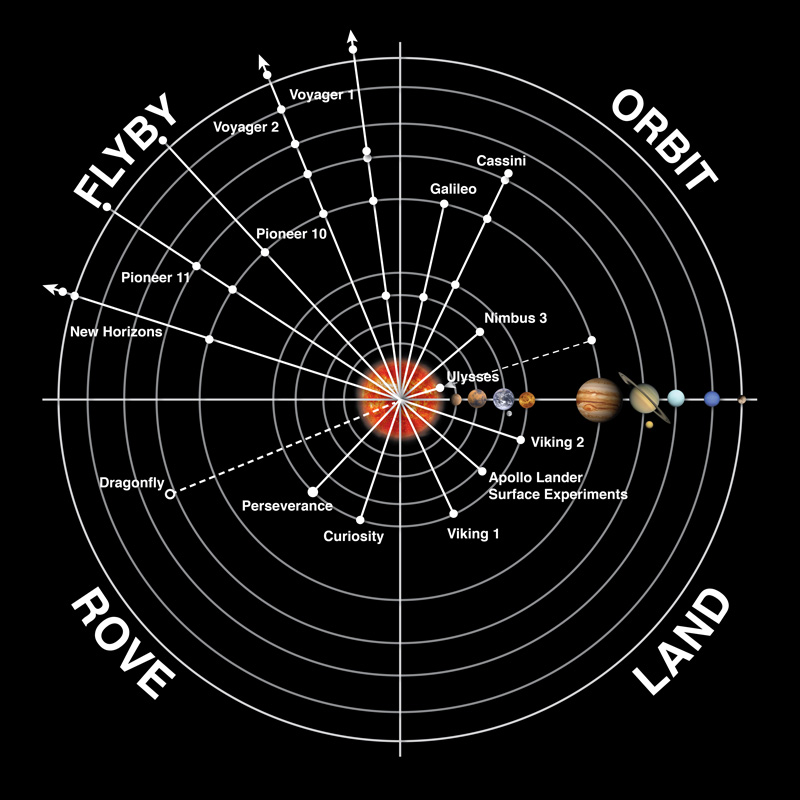Radioisotope Power Systems
NASA RPS Missions
The U.S. Navy launched the first radioisotope power system in 1961. A total of 24 NASA missions have successfully flown with an RPS since 1969. One new mission — NASA's Dragonfly quadcopter — is in development.
Future Missions
- 01
Dragonfly (~2028)
Power for this proposed quadcopter mission to Saturn's Moon Titan would be supplied by a Multi-Mission Radioisotope Thermoelectric Generator (MMRTG) mounted in a cylinder on the back of the drone. The proposed launch date is no earlier than July 2028.

Current Missions
- 01
Mars Perseverance Rover (2020-Present)
The Perseverance rover is powered and warmed by a multi-mission radioisotope thermoelectric generator (MMRTG). The rover has been exploring the surface of Mars since landing in 2021.
- 02
Mars Curiosity Rover (2011-Present)
The Curiosity rover is powered and warmed by a multi-mission radioisotope thermoelectric generator (MMRTG). The rover has been exploring the surface of Mars since landing in 2012.
- 03
New Horizons (2006-Present)
New Horizons is powered by a single radioisotope thermoelectric generator (RTG), which transforms the heat from the natural radioactive decay of plutonium oxide into electricity. The compact, rugged General Purpose Heat Source (GPHS)-RTG aboard New Horizons, developed and provided to NASA by the U.S. Department of Energy, carries approximately 11 kilograms (24 pounds) of plutonium oxide fuel.
- 04
Voyager 1 (1977-Present)
Voyager 1 is powered by a multi-hundred watt radioisotope thermoelectric generator (MHW-RTG) and warmed by nine radioisotope heater units (RHUs). The MHW-RTGs produced about 158 Watts each at launch in 1977. They are still providing power to the spacecraft more than four decades later.
- 05
Voyager 2 (1977-Present)
Voyager 2 is powered by a multi-hundred watt radioisotope thermoelectric generator (MHW-RTG) and warmed by nine radioisotope heater units (RHUs). The MHW-RTGs produced about 158 Watts each at launch in 1977. They are still providing power to the spacecraft more than four decades later.

Past Missions
- 01
Mars Opportunity Rover (2003-2018)
Opportunity was a solar-powered roradioisotope heater units (RHUs) to heat its instruments during cold Martian nights. The rover explored Mars for almost 15 years, far beyond its planned 90 day mission.
- 02
Mars Spirit Rover (2003-2011)
Spirit was a solar-powered rover that used eight radioisotope heater units (RHUs) to heat its instruments during cold Martian nights. The rover explored Mars for more than six years, far beyond its planned 90 day mission.
- 03
Cassini-Huygens (1997-2017)
The Cassini-Huygens mission was powered and heated by three general purpose heat source radioisotope thermoelectric generators (GPHS-RTG) and 117 radioisotope heater units (RHUs). The Cassini orbiter carried the RTGs and 82 RHUs. The Huygens Titan probe carried 35 RHUs. Cassini explored for more than 20 years in space.
- 04
Mars Pathfinder Sojourner Rover (1997)
Sojourner was a solar-powered rover that used three radioisotope heater units (RHUs) to heat its instruments during cold Martian nights. The rover explored Mars for 83 days.
- 05
Ulysses (1990-2009)
The international Ulysses mission used a general purpose heat source radioisotope thermoelectric generator (GPHS-RTGs) to power its long orbits from Jupiter to the poles of the Sun. The spacecraft explored the Sun and our solar system for more than 18 years.
- 06
Galileo (1989-2003)
Galileo was powered and warmed by two general purpose heat source radioisotope thermoelectric generators (GPHS-RTGs) and 120 radioisotope heater units (RHUs). The orbiter included 103 RHUs while its atmospheric probe carried 17. Galileo's mission ended in 2003 after 14 years in space.
- 07
Viking 1 (1976-1982)
The Viking 1 lander was powered by two SNAP-19 radioisotope thermoelectric generators (RTGs). SNAP stands for Systems for Nuclear Auxilliary Power. Viking 1 operated on the surface of Mars from 1976 to 1982.
- 08
Viking 2 (1976-1980)
The Viking 2 lander was powered by two SNAP-19 radioisotope thermoelectric generators (RTGs). SNAP stands for Systems for Nuclear Auxilliary Power. Viking 2 operated on the surface of Mars from 1976 to 1980.
- 09
Pioneer 11 (1973-1995)
Pioneer 11 was powered and heated by four SNAP-19 radioisotope thermoelectric generators (RTGs), with heat from twelve radioisotope heater units (RHUs). First to fly past Saturn, the spacecraft transmitted data back to Earth for 22 years.
- 010
Apollo 17 ALSEP (1972)
The crew of Apollo 17 set up the last Apollo Lunar Surface Experiments Package (ALSEP) on the Moon. It was powered by one SNAP-27 radioisotope thermoelectric generator (RTG). The experiment concluded in 1977.
- 11
Apollo 16 ALSEP (1971)
The crew of Apollo 16 set up an Apollo Lunar Surface Experiments Package (ALSEP) on the Moon. It was powered by one SNAP-27 radioisotope thermoelectric generator (RTG). The experiment concluded in 1977.
- 12
Pioneer 10 (1973-2003)
Pioneer 10 was powered and heated by four SNAP-19 RTGs, with heat from twelve Radioisotope Heater Units (RHUs). First to fly past Jupiter, the spacecraft transmitted back to Earth for more than 30 years.
- 13
Apollo 15 ALSEP (1971)
The crew of Apollo 15 set up an Apollo Lunar Surface Experiments Package (ALSEP) on the Moon. It was powered by one SNAP-27 radioisotope thermoelectric generator (RTG). The experiment concluded in 1977.
- 14
Apollo 14 ALSEP (1971)
The crew of Apollo 14 set up an Apollo Lunar Surface Experiments Package (ALSEP) on the Moon. It was powered by one SNAP-27 radioisotope thermoelectric generator (RTG). The experiment concluded in 1977.
- 15
- 16
- 17
- 18
Nimbus III (1969-1972)
Nimbus III was powered by 10,500 solar cells and two SNAP-19B3 radioisotope thermoelectric generators (RTGs). The weather satellite operated until 1970.
- 19
Nimbus B-1 (1968)
The failure of the Nimbus B-1 launch vehicle forced its destruction by a range safety officer. The spacecraft and and upper stage sank in Santa Barbara Channel. Its SNAP-19B radioisotope thermoelectric generators (RTG)s were recovered and its fuel was reused for Nimbus III

RPS Missions by Destination

RPS-enabled missions have contributed to scientific knowledge across the solar system — and beyond.
Sun | Ulysses (1990-2009 orbit) |
Venus | Cassini (2000 flyby) Galileo (1990 flyby) |
Earth | Cassini (1998 flyby ) Galileo (1990 and 1992 flybys ) Nimbus III (1969-1972) |
Earth's Moon | Apollo 11-17 (Apollo Lunar Surface Experiment Package (1969-1977) |
Mars | Perseverance Rover (2020 - Present) Curiosity Rover (2012 - Present) +Opportunity Rover (2004-2018) +Spirit Rover (2004-2011) +Sojourner Rover (1997) Viking 2 Lander (1976-1982) Viking 1 Lander (1976-1980) |
Asteroids | Galileo (1991 and 1993 flybys) |
Jupiter and its Moons | New Horizons (2007 Flyby) Galileo (1995-2003 orbit) | +Galileo atmospheric probe (1995 descent) Ulysses (1991 flyby, 2004 flyby) Cassini (2000 Flyby) Voyager 1 (1979 flyby) Voyager 2 (1979 flyby) |
Saturn and its Moons | Cassini-Huygens (2004-2017) | +Huygens Titan probe (2005) Voyager 1 (1980) Voyager 2 (1980) Pioneer 11 (1973) |
Uranus and its Moons | Voyager 2 (1986 flyby) |
Neptune and its Moons | Voyager 2 (1989 flyby) |
Pluto and its Moons | New Horizons (2015 flyby) |
Kuiper Belt | New Horizons (2019 flyby) |
Comets | Galileo (1994 observation) |
Interstellar Space | Voyager 1 (2012-Present) Voyager 2 (2018-Present) Note: Pioneers 10 and 11 and New Horizons also are on interstellar trajectories. |
NASA RPS Missions by Type

NASA RPS Missions List
Mission | Power Source | RHUs | Type | Launch Date | Outcome |
|---|---|---|---|---|---|
SNAP-19 B2 | Meteorology (Earth) | 5/18/1968 | Unsuccessful | ||
SNAP-19 B3 | Meteorology (Earth) | 4/14/1969 | Successful | ||
Apollo 11 ALSEP | Solar | 2 | Lunar Experiment | 7/16/1969 | Successful |
SNAP-27 | Lunar Experiment | 11/14/1969 | Successful | ||
SNAP-27 | Lunar Experiment | 4/11/1970 | Unsuccessful | ||
SNAP-27 | Lunar Experiment | 1/31/1971 | Successful | ||
SNAP-27 | Lunar Experiment | 7/26/1971 | Successful | ||
SNAP-19 | 12 | Jupiter Flyby | 3/2/1972 | Successful | |
SNAP-27 | Lunar Experiment | 4/16/1972 | Successful | ||
SNAP-27 | Lunar Experiment | 12/7/1972 | Successful | ||
SNAP-19 | 12 | Jupiter Flyby Saturn Flyby | 4/5/1973 | Successful | |
SNAP-19 | Mars Landing | 8/20/1975 | Successful | ||
SNAP-19 | Mars Landing | 9/9/1975 | Successful | ||
MHW-RTG | 9 | Jupiter Flyby Saturn Flyby Uranus Flyby Neptune Flyby Interstellar Space | 8/20/1977 | In Flight | |
MHW-RTG | 9 | Jupiter Flyby Saturn Flyby Interstellar Space | 9/5/1977 | In Flight | |
GPHS-RTG | 120 | Jupiter Orbiter | 10/18/1989 | Successful | |
GPHS-RTG | Jupiter Flybys Solar Orbiter | 10/6/1990 | Successful | ||
Solar | 3 | Mars Rover | 12/4/1996 | Successful | |
GPHS-RTG | 117 | Saturn Orbiter | 10/15/1997 | Successful | |
Solar | 8 | Mars Rover | 6/10/2003 | Successful | |
Solar | 8 | Mars Rover | 7/7/2003 | Successful | |
GPHS-RTG | Pluto Flyby KBO Flyby | 1/19/2006 | In Flight | ||
MMRTG | Mars Rover | 11/26/2011 | Exploring Martian Surface | ||
MMRTG | Mars Rover | 7/30/2020 | Exploring Martian Surface | ||
MMRTG | Titan Moon Rover (Saturn) | ~2028 | Future Mission |
